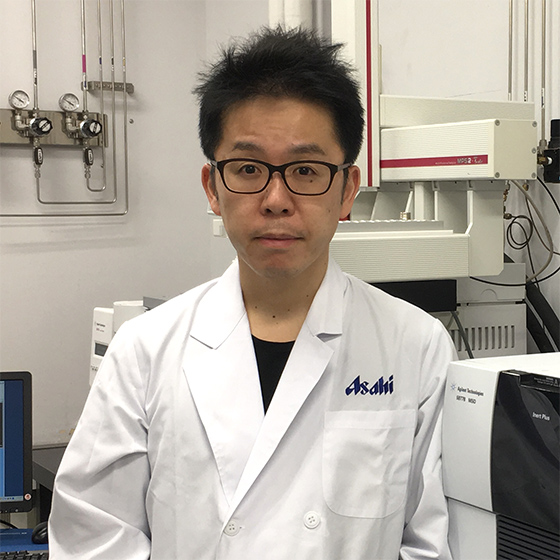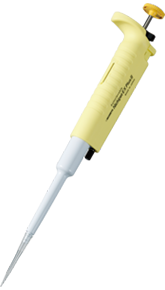PIPETTE / DISPENSER / CUSTOM MADE & OEM
PIPETTE / DISPENSER / CUSTOM MADE & OEM

2018.03 Updated
We talked to Mr. Toru Kishimoto of Asahi Breweries Research Laboratories for Alcohol Beverages.
We analyze the fragrance component of beer, express the quality and strength of scent as analytical value, and based on the results of those we aim to provide products that exceed customers' expectations. The final phenotype of food is "taste and fragrance". For food manufacturers like us we need to produce a large quantity of certain high quality products. For that purpose it is necessary to express the scent and taste of the product as analytical value and manage its analysis value in the manufacturing process. Moreover, if it becomes possible to express the quality of scent and taste as analytical value, we can quickly create "design drawing" of taste and scent of various kinds of products and develop products, respond customer's needs and expectations, market change promptly. My work is to express scents as analytical values by making use of all analytical instruments and extraction methods.

In short, it is used especially when adding 1 μL to 1000 μL of sample or reagent by weighing it when adjusting the substance to the correct concentration needs to be done. There is a "threshold (= concentration that can sense odor)" in the scent, there are fragrance components which do not feel odor unless they exists at high concentration of several hundred ppm, and also there are fragrance components which do feel odor concentration at ppt level (= 1 drop of eye drops in the 50 m pool). A micropipette is indispensable for precisely weighing the sample and the substance to be used and strictly adjusting the concentration at such ppt level. As the Micropipettes is the most versatile experimental instruments among all, we make a best use of Nichiryo’s 1 μL to 10 mL Micropipettes at our everyday experiment.
It is definitely "accuracy". Everyone thinks the accuracy is the most important thing, and maintaining accuracy at all times is looked for. We do not want to see the accuracy gradually goes out at the μL level in the middle of usage and no one notices it. In textbooks, it is said to measure micropipette dispensing capacity with an electronic balance once every three months. If it is a big deviation by mL level, we can notice it with the inspection method, but it is difficult to notice it if it is only a subtle deviation by μL level. The person himself / herself who is experimenting believes in the micropipette's scale, so the one never dream about the accuracy going wrong.
The second feature we want is ease of maintenance. It happens often that researchers aspirates samples or reagents into the inside of the micropipette mistakenly. In such a case, we must immediately clean it by ourselves or replace parts. Nichiryo's pipette has the advantage of being very easy to maintain even by ourselves. Some of the other company’s Micropipettes that we used in the past had structures that could not be disassembled by users like us in order to maintain accuracy, and when we accidentally aspirate samples and reagents into the inside, every time we used to send them to the manufacturer to clean it. I understood the intention of keeping accuracy, but such a structure that is difficult to maintain is not what we want.

Acids and solvents can be used. In our experiment, there are almost no cases when we weigh materials other than acids and solvents. In the experiment, experimental system is scheduled by varying pH condition and polarity condition. When changing the pH condition, add it while strictly adjusting the amount of acid or alkali with a micropipette, and when changing the polarity condition, add it while precisely adjusting the amount of solvent with a micropipette. We also dissolve samples and reagents in acid, alkali, solvent and dispense them. In any case, it is more common to aspirate acid or solvent with a micropipette. Many of the Micropipettes manufactured by other manufacturers use packing materials made of metal and solvent that are used in the inner structure, and they are not very resistant to acids nor solvents, and that was a problem for us. When using such a micropipette, accuracy was deteriorated frequently and it was noticed that apparently accuracy got deteriorated during use.
At that time, Nichiryo introduced us Nichipet EX Plus. Nichipet EX Plus has an internal structure composed of PTFE and perfluorinated rubber packing, and acid and solvent can be used. Anyway, as a response from the users around us, every one of our colleagues are extremely pleased saying "The capacity is not going wrong with repeated use." As a result, all pipettes became Nichipet EX Plus as shown in the picture.

The point that I am most pleased with is that as mentioned above, "even if we use more, the capacity does not go wrong". In addition, Nichiryo come back to the regular inspection twice a year, and perform operation check of all Micropipettes, air leakage inspection, simple volume inspection, and they find abnormality at an early stage. Furthermore, we regularly use Nichiryo's JCSS calibration / verification service, and thanks to these support, we are using Micropipettes very much comfortably.
Furthermore, Nichiryo has been holding pipette training course and it is very helpful for us. In our company, persons in charge of experiments are frequently replaced, and some of those newly in charge are concerned about how to use the micropipette. For such persons training course are very helpful.
Of course, as I mentioned at the beginning, we aim to express the quality and strength of the fragrance of beer as an analytical value and connect the achievement to the products that exceed customers' expectations. For that purpose, it is necessary to more precisely express the quality and strength of the fragrance of beer as an analytical value, and it is also necessary to precisely quantify more kinds of trace components. To that end, we need more precise quantitative and analysis as mentioned, and I am certain that the needs and expectations for Nichiryo's Micropipette will increase more and more.

Advanced durability against organic solvent dispensing.
( Acid・Alkalies, Ketone・Ester, Aldehyde )
NIchipet EX PlusⅡ:
https://www.nichiryo.co.jp/en/product/pipette/explus2/

Select a Region / Language
Asia-Pacific
Americas
Europe, Africa, Mid East